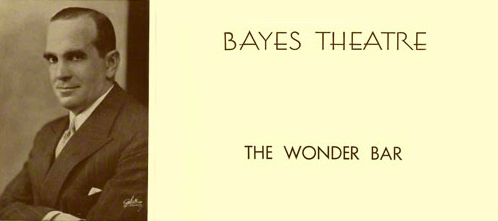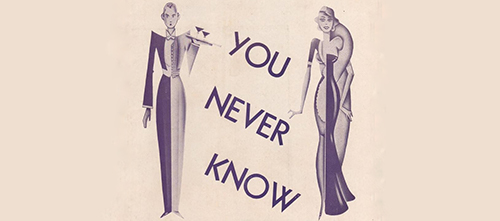Pas de biographie disponible.
Compositeur Musique additionelle Librettiste Parolier Metteur en scène Chorégraphe Producteur création Producteur version

Musical
Musique: Robert Katscher • Paroles: Irvin Caesar • Livret: Geza Herczeg • Karl Farkas • Production originale: 2 versions mentionnées
Dispo: Résumé Génèse Isnpiration Liste chansons
Genèse: Avec "The Wonder Bar", la superstar de Broadway Al Jolson revient au théâtre après presque six ans. Sa plus récente apparition remonte à août 1925, avec le retour à Broadway de "Big Boy", qui avait ouvert ses portes en janvier de la même année. Il était entré dans l’histoire du cinéma en jouant dans le premier film parlant "The Jazz Singer" en 1927. Il a rapidement enchainé après ce premier film historique avec des rôles de premier plan dans quatre autres films musicaux entre 1928 et 1930, et une apparition non créditée dans un autre. Mais les critiques et le public furent totalement indifférents à "The Wonder" Bar et le spectacle s'est joué moins de dix semaines. Plus tard, Jolson a tourné avec ce musical et, en 1934, il jouera dans l’adaptation cinématographique de First National Pictures-Warner Brothers, et peut-être que le succès du film a fait oublier le musical à la scène. "The Wonder Bar" était une « nouveauté continentale de la vie nocturne européenne » qui se déroulait au Wonder Bar, une discothèque parisienne appartenant à Monsieur Al (Jolson). Pour l’occasion, le (Nora) Bayes Theatre a été transformé en une boîte de nuit rouge, noir et or où le public du théâtre se retrouvait assis à table et pouvait même danser sur la scène avant le début de chaque représentation (une note dans le programme annonçait qu’il y avait des danses sur la scène avant le début de la pièce et que les membres du public étaient cordialement invités à y participer). Situé au-dessus du Weber & Fields Music Hall (plus tard le 44th Street Theatre), le Bayes était à l’origine connu sous le nom de Lew Fields’ 44th Street Roof Garden. Pour "The Wonder Bar", la scène du Bayes a été reconfigurée de sorte qu’elle s’est étendue jusque dans l’auditorium et a ainsi supprimé la séparation entre la scène et la salle (avec ses tables et chaises au lieu de sièges de théâtre réguliers) dans un espace unique qui a créé l’illusion d’une grande discothèque. Incidemment, une note de programme indiquait que « les adaptateurs remercient M. George Jessel pour ses suggestions utiles ». En un sens, la soirée aurait pu être intitulée "Grand Nightclub" parce qu’elle se résumait à regarder le spectacle des clients, du personnel et des artistes du club. Et Jolson était en fait une sorte de maître-concierge qui observait et orchestrait les événements dans ce monde des cocottes nocturens, des gigolos, des amuseurs, des barmen, des serveurs, des « garçons en manteau de fourrure», des fumeuses de cigarettes et … des touristes. Le spectacle était moins un musical à livret qu’un spectacle avec des chansons et des danses qui étaient interprétées comme divertissement pour les clients du club.
Résumé: Le scénario était centré sur des danseurs professionnels Inez (Trini) et Ramon (Rex O’Malley), et leur relation litigieuse. Le musical se déroulait sur une période d’un an. Cette histoire éparpillée s'intéressait également à des bijoux volés, des gigolos, une histoire d’amour illicite, et même au krach boursier!
Création: 17/5/1931 - Nora Bayes Theatre (Broadway) - 76 représ.

Musical
Musique: Cole Porter • Robert Katscher • Paroles: Cole Porter • Livret: Rowland Leigh • Production originale: 1 version mentionnée
Dispo: Résumé Commentaire Génèse Liste chansons
You Never Know is a musical with a book by Rowland Leigh, adapted from the original European play By Candlelight, by Siegfried Geyer and Karl Farkas, with music by Cole Porter and Robert Katscher, lyrics by Cole Porter, additional lyrics by Leigh and Edwin Gilbert, directed by Leigh, and songs by others. The show was written not long after the riding accident that left Porter semi-crippled, and is considered one of the flops he wrote before his return to prominence with Kiss Me, Kate.[1]
Genèse: The show was first produced in Europe with a small cast, but the Shubert Brothers (who produced it for Broadway), did not want to produce it with no chorus or large stage numbers. They hired Porter and other composers to write extra material, and when it premiered on Broadway in 1938 it was no longer a chamber musical, but a typical 1930s "big musical". Original Broadway cast Produced by John Shubert, the Broadway production, opened on September 21, 1938 at the Winter Garden Theatre, where it ran for 78 performances, after tryouts in New Haven, Boston, Washington, Philadelphia, Chicago, and Indianapolis, among others. The cast featured Clifton Webb, Lupe Vélez, Libby Holman, Toby Wing (later replaced by June Havoc), and Rex O'Malley. Later productions It was staged Off-Broadway at the Eastside Playhouse from March 12 to March 18, 1973, lasting only 8 performances. The show was directed and production design by Robert Troie and musically directed by Walter Geismar. The show starred Esteban Chalbaud, Lynn Fitzpatrick, Dan Held, Rod Loomis, Grace Theveny, and Jamie Thomas.[4] The number Greek To You, They All Fall In Love, and You've Got That Thing was added. In 1975, there was a regional production of the show put on in Ogunquit, Maine at the Ogunquit Playhouse from August 4 to August 9. The show starred Bob Wright, Kitty Carlisle, Joe Masiell, and Bernice Massi.[6][7] This production added Porter numbers from other works, including the songs After You, Who? (Gay Divorce), Greek To You (Greek To You), It Must Be Fun To Be You (cut from Mexican Hayride), Waltz Down The Aisle (Ever Yours), What A Fair Thing Is A Woman (cut from Can Can), What Does Your Servant Dream About? (cut from Kiss Me, Kate), and Who Knows? (Rosalie). May 26, 1991 was the opening night of You Never Know at the Pasadena Playhouse in Pasadena, California. The show was directed by Paul Lazarus, musical director John McDaniel, set design James Leonard Joy, lighting design Martin Aronstein, costume design Reve Richards, sound design Jack Allaway, choreography by Thommie Walsh, and musical supervision, arrangements, and orchestrations Steve Orich. The show starred David Garrison (Gaston), Harry Groener (Baron), Kurt Knudson (Herr Baltin), Donna McKechnie (Baltin), Megan Mullally (Maria), and Angela Teek (Ida). There was an Off-Broadway revival in 1996 at the Paper Mill Playhouse. The show was directed by Charles Repole, set design Michael Anania, costumes by Gregg Barnes, lighting Tom Sturge, sound David R. Paterson, music direction John Mulcahy, and choreography by Michael Lichtefeld. The show starred Stephanie Douglas (Maria), Nancy Hess (Baltin), Tom Ligon (Herr Baltin), Michael O'Steen (Gaston), John Scherer (Baron), and KT Sullivan (Ida). It had a limited run from April 14–24, 2009 at the McGinn/Cazale Theatre. The show was directed by Thomas Sabella-Mills, lighting design Yingzhi Zhang, musical direction by James Stenborg. The show starred James Zanelli (Baron), Kevin Kraft (Gaston), Kate Marilley (Baltin), Jennifer Evans (Maria), Christy Morton (Ida), Bill Coyne (Waiter), and Todd Faulkner (Herr Baltin).
Résumé: Maria, maid to Mme. Baltin, impersonates her mistress while carrying out an assignation with the Baron de Romer's valet, Gaston, whom she believes to be the Baron himself. The Baron discovers the pair, but, being a good sport, he assumes the role of his servant in order to assist Gaston in his romantic pursuit. When Mme. Baltin discovers her maid's deceit, she is less of a good sport and exposes the masquerade. All ends happily, though, as the foursome sup by candlelight. Other characters include the Baron's gregarious friend Ida Courtney and Mme. Baltin's cheating husband, Henri, the dry goods king of France.
Création: 21/9/1938 - Winter Garden Theatre (Broadway) - 78 représ.

.png)
.png)




